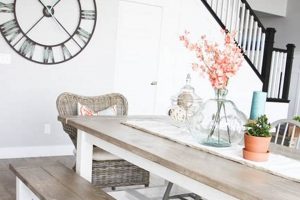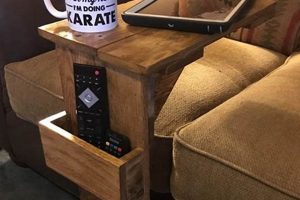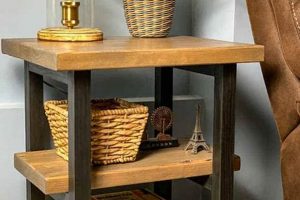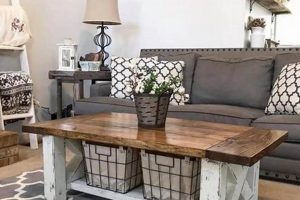A do-it-yourself table constructed using reclaimed wooden platforms represents a cost-effective and environmentally conscious approach to furniture creation. This method leverages readily available materials, transforming them into functional and aesthetically pleasing pieces suitable for various indoor and outdoor settings. For example, standard-sized shipping platforms can be disassembled, repurposed, and reassembled into a coffee table, dining table, or outdoor patio table.
The significance of constructing furniture in this manner lies in its potential to reduce waste and promote sustainable practices. Utilizing discarded platforms minimizes reliance on newly manufactured materials, contributing to resource conservation. Historically, repurposing materials has been a necessity and a creative outlet; this method allows individuals to engage in both traditions while creating personalized furnishings. The benefits extend to cost savings, unique design customization, and the satisfaction of creating something functional from reclaimed resources.
The subsequent sections will explore essential considerations, including platform selection criteria, necessary tools and materials, step-by-step construction methodologies, and surface finishing techniques. This detailed exploration provides a practical guide for individuals interested in undertaking this type of project.
Essential Construction Guidelines
The following guidelines address crucial aspects of constructing furniture from reclaimed platforms, ensuring structural integrity and aesthetic appeal.
Tip 1: Platform Assessment: Thoroughly inspect all platforms for structural damage, rot, or insect infestation before use. Select platforms composed of heat-treated (HT) wood and avoid those marked with “MB” (methyl bromide), a toxic fumigant.
Tip 2: Safety Precautions: Employ appropriate personal protective equipment, including safety glasses, gloves, and a dust mask, throughout the entire process. Woodworking activities generate dust particles that pose respiratory hazards.
Tip 3: Disassembly Techniques: Use a pry bar and hammer to carefully dismantle the platform structure. Exercise caution to avoid splitting or damaging the wood during disassembly.
Tip 4: Wood Preparation: Sand all surfaces to create a smooth finish and remove splinters. The degree of sanding will depend on the desired aesthetic, ranging from rustic to highly polished.
Tip 5: Joint Reinforcement: Employ wood glue and screws or nails to reinforce joints, ensuring structural stability. Consider using metal brackets or plates for additional support in load-bearing areas.
Tip 6: Surface Treatment: Apply a sealant or finish to protect the wood from moisture and wear. Options include polyurethane, varnish, or exterior-grade stains, depending on the intended use environment.
Tip 7: Design Considerations: Plan the design meticulously, taking into account the platform dimensions and the desired functionality. Accurate measurements and precise cuts are essential for achieving a professional result.
Adhering to these guidelines enhances the safety, durability, and visual appeal of the finished piece. Careful platform selection and meticulous construction techniques are paramount.
The subsequent section will provide information on additional design possibilities and customization strategies to create unique pieces of furniture.
1. Wood Selection
The selection of appropriate wood is a foundational element in the construction of do-it-yourself tables from reclaimed wooden platforms. The characteristics of the chosen wood directly influence the structural integrity, aesthetic quality, and overall longevity of the finished product.
- Platform Type
Various platform types exist, each with distinct wood species, construction methods, and prior usage. Standard North American platforms often utilize hardwoods like oak or maple, while European platforms may employ softer woods such as pine or fir. The wood type influences durability, resistance to wear, and the final appearance. Selecting platforms based on intended use and aesthetic preferences is paramount.
- Treatment and Safety
Platforms undergo treatments to prevent pest infestation and decay. Heat treatment (HT) is a safe method, while methyl bromide (MB) fumigation is a hazardous process. Platforms marked with “MB” should be avoided due to potential toxicity. Verifying the treatment method ensures a safe working environment and prevents the introduction of harmful chemicals into the home.
- Wood Condition
The condition of the wood affects the structural stability of the table. Inspecting for signs of rot, insect damage, or significant warping is crucial. Wood exhibiting substantial damage should be discarded. Sound wood ensures a stable foundation for the tabletop and legs, contributing to the overall robustness of the final product.
- Aesthetic Considerations
The grain pattern, color, and texture of the wood contribute significantly to the aesthetic appeal of the table. Different wood species offer distinct visual characteristics. Knotty wood may provide a rustic appearance, while smoother wood may lend itself to a more refined aesthetic. Considering the desired style and selecting platforms with complementary visual characteristics enhances the finished piece.
Careful consideration of platform type, treatment method, wood condition, and aesthetic qualities ensures the selection of wood suitable for constructing durable, safe, and visually appealing furniture. The choice directly impacts the structural integrity and the overall aesthetic of the do-it-yourself table. These factors must be carefully evaluated prior to commencing the construction process.
2. Safety Measures
The construction of furniture from reclaimed wooden platforms necessitates strict adherence to safety measures to mitigate potential hazards. The inherent nature of repurposed materials, coupled with the use of power tools, presents risks that demand careful consideration. Failure to implement proper safety protocols can result in injuries ranging from minor cuts and abrasions to more severe lacerations, fractures, or exposure to hazardous substances. For instance, using platforms without first ensuring they are free of protruding nails or staples can lead to puncture wounds. Similarly, inadequate ventilation during sanding or finishing can cause respiratory irritation from airborne particles or chemical fumes. Therefore, safety measures are not merely recommended, but constitute an essential component of successful and responsible furniture construction.
Specific safety protocols include the consistent use of personal protective equipment (PPE), such as safety glasses, gloves, and respirators. Eye protection shields against flying debris generated during sawing, sanding, or hammering. Gloves protect hands from splinters, sharp edges, and potential chemical exposure. Respirators filter out harmful dust particles and volatile organic compounds released during finishing processes. A well-ventilated workspace is crucial to prevent the accumulation of harmful fumes. Additionally, proper tool handling techniques and adherence to manufacturer’s instructions are vital. Unsecured workpieces or improper tool usage can result in accidents and injuries. Inspecting platforms for structural integrity and the presence of hazardous materials before commencing work is also a necessary precaution. Using platforms treated with methyl bromide, a toxic fumigant, poses a serious health risk and must be avoided.
In summary, safety measures are inextricably linked to the successful execution of do-it-yourself furniture projects using reclaimed platforms. The implementation of appropriate safety protocols minimizes the risk of injury, promotes a safe working environment, and ensures a positive and productive experience. A comprehensive understanding of potential hazards and adherence to established safety guidelines are paramount to protect individuals and ensure the sustainable and responsible use of reclaimed materials.
3. Design Planning
Design planning is a critical precursor to the successful construction of a table from reclaimed wooden platforms. It provides a structured framework for translating conceptual ideas into tangible objects, ensuring that the finished piece meets both functional and aesthetic requirements. Without comprehensive design planning, projects can suffer from structural instability, dimensional inaccuracies, and an overall lack of cohesion.
- Dimensional Considerations
Accurate measurement of the available space and precise determination of the desired table dimensions are paramount. Factors such as leg height, tabletop surface area, and overall proportions directly impact the usability and visual harmony of the piece. For instance, a dining table requires a significantly larger surface area than a coffee table, necessitating careful consideration of platform dimensions and potential modifications. Failure to account for these factors can result in a table that is either impractical or aesthetically displeasing.
- Structural Integrity
Design planning must address the structural stability of the table. The weight-bearing capacity of the platform wood, the type of joinery employed, and the placement of support structures are all critical considerations. Utilizing reinforced joints, such as mortise and tenon or metal brackets, can enhance the table’s ability to withstand weight and resist stress. For example, a table intended to support heavy objects, such as books or appliances, necessitates a more robust structural design compared to a purely decorative piece. Insufficient structural planning can lead to collapse or premature failure.
- Aesthetic Integration
The design should integrate seamlessly with the intended environment and reflect the desired aesthetic style. Considerations include wood finish, leg design, and overall form. A rustic aesthetic might necessitate a natural wood finish and simple, unadorned legs, while a more contemporary style might incorporate sleek lines and a polished surface. The selection of appropriate hardware, such as screws, nails, and fasteners, should also align with the overall aesthetic. Lack of attention to aesthetic integration can result in a table that appears incongruous within its surroundings.
- Material Optimization
Effective design planning considers how to optimally utilize available platform materials. This includes minimizing waste through efficient cutting layouts, maximizing the use of structurally sound sections, and creatively repurposing smaller pieces. For example, excess platform wood can be used to create decorative elements, shelves, or other functional components. This approach minimizes material costs and promotes sustainable practices. Inefficient material utilization can lead to unnecessary waste and increased project expenses.
These elements of design planning are interconnected and mutually reinforcing. A comprehensive design process ensures that the resulting table is not only visually appealing but also structurally sound and functionally appropriate. By prioritizing design planning, individuals can increase the likelihood of a successful and satisfying do-it-yourself project.
4. Joint Strength
The structural integrity of any table, particularly one constructed from reclaimed wooden platforms, is fundamentally dependent on the strength of its joints. Joints are the points at which individual components are connected, and their ability to withstand stress and weight directly dictates the overall stability and longevity of the piece. In the context of a do-it-yourself project utilizing platforms, the variable quality and potentially compromised nature of the wood necessitate meticulous attention to joint construction. Weak or poorly executed joints are prone to failure, leading to instability, sagging, or complete collapse of the table. For example, a table constructed with simple butt joints held together solely with nails will likely fail under significant load, whereas a table incorporating mortise and tenon joints reinforced with adhesive will exhibit far greater resilience.
Several factors influence the effectiveness of joints in platform-based table construction. The type of joint employed, such as butt joints, lap joints, mortise and tenon joints, or dovetail joints, each offer varying degrees of strength and complexity. The selection of appropriate fasteners, including screws, nails, or bolts, is also crucial. Screws generally provide greater holding power than nails, especially in softer woods commonly found in platforms. Adhesive selection further contributes to joint strength; wood glue designed for exterior use is advisable for tables intended for outdoor environments. Furthermore, the precision with which joints are cut and assembled significantly impacts their effectiveness. Gaps or misalignments reduce the surface area for adhesion and weaken the overall structure. Real-world applications highlight the importance of robust joints. A coffee table intended to hold books or decorative items requires stronger joints than a purely ornamental side table. A dining table, subject to frequent use and varying loads, demands exceptionally durable joint construction.
In summary, joint strength is an indispensable element in the successful construction of tables from reclaimed wooden platforms. It directly influences the structural stability, safety, and longevity of the finished product. Careful consideration of joint type, fastener selection, adhesive application, and precision in assembly are paramount. Overlooking the importance of joint strength can result in a compromised and ultimately unusable piece of furniture. Recognizing and addressing the specific challenges associated with using reclaimed platform wood is essential for achieving a durable and aesthetically pleasing outcome.
5. Surface Finish
The surface finish applied to a do-it-yourself table constructed from reclaimed wooden platforms directly influences its aesthetic appeal, durability, and resistance to environmental factors. The selection and application of the appropriate finish are critical steps in ensuring the longevity and functionality of the furniture piece.
- Protection Against Environmental Elements
The primary function of a surface finish is to protect the wood from moisture, ultraviolet radiation, and physical abrasion. Exterior-grade finishes, such as spar varnish or marine-grade polyurethane, offer superior protection against weathering, making them suitable for outdoor tables. Interior finishes, like lacquer or shellac, provide adequate protection for indoor use. Untreated wood is susceptible to warping, cracking, and decay, significantly reducing the lifespan of the furniture. A properly applied finish creates a barrier that prevents moisture absorption and minimizes the effects of sunlight exposure, thereby preserving the structural integrity and appearance of the wood.
- Enhancement of Aesthetic Qualities
Surface finishes enhance the natural beauty of the wood grain and can alter the color and sheen of the tabletop. Clear finishes, such as polyurethane or varnish, highlight the inherent characteristics of the wood, while stains can be used to modify the color to match existing dcor. Different sheen levels, ranging from matte to high-gloss, can create varying visual effects. A matte finish provides a subtle, natural look, whereas a high-gloss finish creates a reflective surface that accentuates the wood’s texture. The careful selection and application of a surface finish can transform a rough, reclaimed platform into a polished and visually appealing piece of furniture.
- Facilitation of Cleaning and Maintenance
A durable surface finish simplifies cleaning and maintenance, preventing stains, spills, and dirt from penetrating the wood fibers. Finishes like polyurethane and epoxy create a smooth, non-porous surface that is easily wiped clean with a damp cloth. Untreated wood is more susceptible to staining and requires more intensive cleaning methods. A properly finished table is resistant to common household spills, such as coffee, wine, and food stains, ensuring that it maintains its appearance over time. Regular cleaning with mild detergents is typically sufficient to keep a finished table looking its best, minimizing the need for more abrasive cleaning agents.
- Mitigation of Health and Safety Concerns
Certain surface finishes can mitigate health and safety concerns associated with reclaimed wood. Encapsulating the wood with a non-toxic sealant prevents the release of any residual chemicals or contaminants that may be present. Finishes labeled as “low-VOC” (volatile organic compounds) minimize the emission of harmful fumes, improving indoor air quality. Additionally, a smooth, well-finished surface reduces the risk of splinters and sharp edges, making the table safer to use, particularly for households with children. Prioritizing health and safety considerations during the finishing process ensures that the reclaimed platform table is both aesthetically pleasing and environmentally responsible.
The strategic application of a suitable surface finish is paramount in the transformation of reclaimed wooden platforms into functional and aesthetically pleasing tables. The selected finish safeguards the wood against environmental factors, enhances its natural beauty, facilitates ease of maintenance, and mitigates potential health risks. Neglecting this critical step can compromise the table’s durability and visual appeal, diminishing the overall value of the do-it-yourself project.
6. Cost Efficiency
The economic advantage constitutes a significant driver in the decision to construct furniture from reclaimed wooden platforms. Material acquisition represents a primary cost-saving factor. Platforms are often obtainable at minimal expense or even without charge from various sources, including shipping companies, construction sites, and retail establishments. This contrasts starkly with the cost of purchasing new lumber from a commercial supplier, which can be substantial depending on the species and grade of the wood. The initial investment in materials is therefore reduced, providing a foundation for overall cost-effectiveness. The degree of savings realized directly correlates to the accessibility of inexpensive platforms and the extent to which purchased materials, such as fasteners and finishes, are minimized.
Furthermore, labor represents another area where cost efficiency can be achieved. Constructing furniture from platforms is a do-it-yourself endeavor, eliminating the expense of hiring a professional furniture maker. However, it is crucial to acknowledge that labor is not without cost. The time invested in dismantling platforms, preparing the wood, constructing the table, and applying the finish has an economic value, even if it is not an out-of-pocket expenditure. An individual’s time has an opportunity cost, representing the value of what could have been accomplished during that time had it been allocated to a different activity. Therefore, individuals must consider their own time constraints and skill levels when assessing the overall cost-effectiveness of this approach. If specialized tools are required and need to be purchased, this cost must also be factored into the calculation. A balanced assessment weighs material savings against the time invested and the potential need for additional tools or resources. A practical example would be an individual who, due to time constraints, is unable to source free platforms and instead purchases them at a nominal cost. Even with this expense, the total cost may still be significantly lower than that of purchasing a comparable table from a retail furniture store.
In conclusion, the cost efficiency of constructing furniture from reclaimed platforms is a multifaceted consideration. While the potential for material savings is substantial, it is essential to account for the economic value of labor, the potential need for specialized tools, and the individual’s skill level. A comprehensive evaluation, encompassing both tangible expenses and intangible opportunity costs, provides a realistic assessment of the economic benefits of this do-it-yourself approach. The availability of low-cost platforms, coupled with efficient resource management and careful planning, is paramount to maximizing cost savings and achieving a truly economical outcome.
Frequently Asked Questions
This section addresses common inquiries and concerns regarding the construction of tables using reclaimed wooden platforms. The information presented aims to provide clarity and guidance for individuals considering such a project.
Question 1: What are the primary safety considerations when working with reclaimed wooden platforms?
Reclaimed wooden platforms may present several safety hazards. Thorough inspection for protruding nails, staples, or splinters is essential before handling. The use of appropriate personal protective equipment (PPE), including safety glasses, gloves, and a dust mask or respirator, is mandatory to prevent injuries. Working in a well-ventilated area is crucial to minimize exposure to dust and potential chemical residues. Platforms treated with methyl bromide should be strictly avoided due to their toxicity.
Question 2: How does one determine if a wooden platform is suitable for furniture construction?
Suitability depends on several factors. The platform should be structurally sound, free from excessive rot or insect damage. Heat-treated (HT) platforms are preferable to those treated with chemicals. The wood species and overall dimensions should align with the intended table design. Platforms marked with “MB” (methyl bromide) are unsuitable and should not be used.
Question 3: What are the essential tools required for constructing a table from reclaimed wooden platforms?
Essential tools include a hammer, pry bar, circular saw or hand saw, drill, screwdriver, measuring tape, sander, and clamps. Additional tools, such as a planer or jointer, may be beneficial for achieving a smoother surface finish. The specific tools required will depend on the complexity of the intended design.
Question 4: What type of joinery is recommended for ensuring structural stability in a platform table?
Various joinery methods can be employed, depending on the desired strength and aesthetic. Mortise and tenon joints, lap joints, and dovetail joints offer superior strength compared to simple butt joints. Reinforcement with screws and wood glue is recommended for all joint types. Metal brackets or plates can provide additional support in load-bearing areas.
Question 5: How should the surface of a platform table be treated to enhance its durability and appearance?
Surface treatment involves sanding, staining (optional), and sealing with a protective finish. Sanding removes imperfections and creates a smooth surface. Staining adds color and enhances the wood grain. A sealant, such as polyurethane or varnish, protects the wood from moisture, scratches, and UV damage. The choice of finish depends on the intended use and desired aesthetic.
Question 6: Is it necessary to disassemble the platform entirely before beginning construction?
Complete disassembly is not always necessary. The design may incorporate sections of the platform structure directly. However, disassembly allows for greater flexibility in design and facilitates the selection of the most structurally sound and visually appealing pieces. The decision depends on the specific design and the condition of the platform.
Key takeaways include the importance of safety, platform assessment, appropriate tools, strong joinery, durable surface finishes, and adaptable designs. These factors contribute to the creation of functional and aesthetically pleasing furniture.
The subsequent section will explore advanced design techniques and finishing options to elevate the artistry of reclaimed platform tables.
DIY Table Out of Pallets
The preceding discussion has explored the multifaceted aspects of constructing a diy table out of pallets. Key considerations encompass platform selection, safety protocols, design planning, joint integrity, surface treatments, and cost-effectiveness. A comprehensive understanding of these elements is paramount for successful project completion and the creation of durable, aesthetically pleasing furniture.
The endeavor represents a convergence of sustainable practices and individual craftsmanship. The mindful application of these principles enables the transformation of reclaimed resources into functional art, contributing to both environmental responsibility and personalized design. Further investigation and innovation in repurposing materials hold the potential for expanding sustainable practices within furniture construction and beyond.







